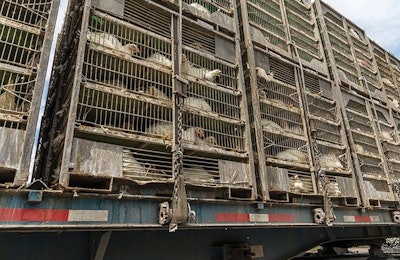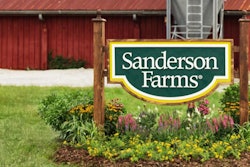
In the modern poultry industry, improving animal welfare means showing continual, gradual improvement in objective welfare measurements.
That’s what a panel of animal welfare professionals representing bird genetics, academia and integrated poultry production said as part of a panel on the topic hosted by WATT PoultryUSA at the 2020 International Production & Processing Expo (IPPE) in Atlanta. The panelists were:
- Karen Christensen, senior director of animal wellbeing at Tyson Foods
- Dr. Karen Schwean-Lardner, associate professor in the Department of Animal and Poultry Science at the University of Saskatchewan
- Ann-Marie Neeteson, Vice President of Welfare and Compliance, Aviagen
Is natural light necessary?
The role of light in broiler welfare is becoming better understood. Properly utilizing this resource can improve animal wellbeing and, potentially, performance.
In recent years, major poultry producers – including Perdue Foods and Wayne Farms LLC – started installing windows in their broiler housing to let natural light in. Some third-party welfare certification organizations, like the Global Animal Partnership, call for access to natural light, too.
In practice, adding natural light is challenging for an industry typically growing birds in dim, artificially lit environments. More light leads to more stimulation and therefore more bird activity in the house.
Schwean-Lardner said she is unclear if there is any scientific evidence adding access to natural light makes an impact on the birds. There are examples, she said, of adding windows in houses and creating light and dark spots where birds crowd.
“Using windows to let in natural light, we don’t know that it’s great, we don’t know that it’s bad other than it changes stocking density and it changes some behaviors,” Schwean-Lardner said.
Christensen said her goal is to avoid making changes that seem good to the human eye but are harmful to the avian eye. Understanding the bird’s view starts from their evolutionary past as a junglefowl. As an animal at the bottom of the food chain, it needed to hide to survive.
She cited one study she worked on which studied how birds fed in different light intensities. It suggested a bird wants to eat quickly in bright light, by loading its crop, and then retreat to darkness to digest. The avian eye may also use ultraviolet A light to spot food.
Using that study, Christensen is trying to replicate that environment in a chicken house. That design uses a bright light centered over feed and then presents gradients of darkness where they can hide. In this scheme, she is seeing greater expression of natural behaviors, too.
Neeteson noted that animal welfare researchers shouldn’t exclusively use the wild junglefowl as a benchmark for research. Just as a wolf and a dog are distinct species, the broiler bird in production today is highly selected and genetically modified from its wild ancestors.
How long should the house be dark?
Research also suggests the amount of time a house should be totally dark or totally lit needs to match the natural cycle of day and night.
Schwean-Lardner said experiments she worked on tested how long of a dark period a bird needed. It tested ranges of darkness from four to 10 hours. A bird will wake up and eat after seven to eight hours, she said, but feed efficiency is greater when the dark period is longer. Birds do need at least four hours of darkness, however.
Is the light color important?
Schwean-Lardner said extant scientific literature is contradictory. Some studies say more blue light will cause better growth rate and more muscle fibers on breast meat. Others will say yellow is needed. Still others say the color of light doesn’t matter.
In a study she was involved with, she compared light colors and saw no difference in results for growth rate and feed efficiency but a difference in behaviors. In white or green light, bird behavior is normal. But in a blue light, the birds come toward people instead of running away from them. Further work is underway to know why.
Christensen said the benefit of artificial lighting is the ability to recreate the light levels and colors the bird prefers inside the poultry barn. Her anecdotal experience suggests the birds prefer colors matching the sky during the times of day. Bright white at midday and with a touch of red at the early and late hours of the day.
Which enrichments work?
Farmers are also starting to introduce objects into the house exclusively to engage or entertain the birds known as enrichments. There is evidence birds prefer to peck at and hide under objects.
Neeteson said enrichments are used at Aviagen breeder farms and the birds enjoy them. One object she highlighted was a straw rope for the birds to peck. She said the jury is still out on whether an enrichment makes a difference, but she believes farmers enjoy them and the birds enjoy them.
Christensen said she’s reviewed the range of objects available and it seems the birds prefer hut style objects they can hide and group under. Birds will actively play, she said, by pushing other birds out of the hut.
Both said there is much variance in what kind of enrichments the birds find amusing. Sometimes effectiveness will vary from bird to bird or flock to flock.
What are the best, objective welfare measurements?
Animal welfare is sometimes subjective. More objective measures help to establish a better understanding and level playing field.
Christensen said the overall goal when it comes to these objective measures is steady, continuous improvement. Perfection is not possible, but transparent improvement is. Tyson will start to track several welfare measures and, as part of its annual report, reflect on why it did better or did worse every year.
For now, she said she’s focused on paw scores. These indicators show much information about the quality of the housing and the true welfare of the bird. Another indicator to monitor in the future will be how the birds are handled at catch and during transportation and slaughter.
Schwean-Lardner said it’s better to consider animal welfare as more than a single measurement. She considers paw scores, mobility levels and hormone levels together. Christensen said those levels of cortisol and melatonin and dopamine are all considered but are hard to accurately measure.
Poultry producers, Christensen said, must make decisions based on performance but it must balance welfare. Using objective measurements and monitoring flocks for tangible health and welfare issues helps farmers know they are successfully balancing animal performance with animal wellbeing.
What role will automated welfare systems play?
As the wave of internet-enabled precision agriculture innovation arrives to the poultry industry, there are potential new tools for monitoring bird welfare in the house that could significantly impact the business. Right now, the panelists said there is exciting development in the area but automated welfare monitoring technology should only be another tool rather than a total replacement for the farmer.
Neeteson said there is already development in welfare monitoring in Europe, with scientists and poultry industry groups working in concert to advance the technology. Nevertheless, she said the technology isn’t ready for the field yet.
In the future, these systems will need to be able to communicate with other monitors and controllers in the house to yield the best results. Also, anything added to the house needs to be practical to use and affordable for the farmer.
Christensen said advances in visual and auditory monitoring as well as in-house robotics will help farmers and academics better understand the bird but they cannot replace good animal husbandry. Practically, these systems should be viewed as a potential early warning system and as a 24-hour watchman for the farmer. As a part of other precision agriculture measures, automated monitoring would help enable better decisions and better results.


















